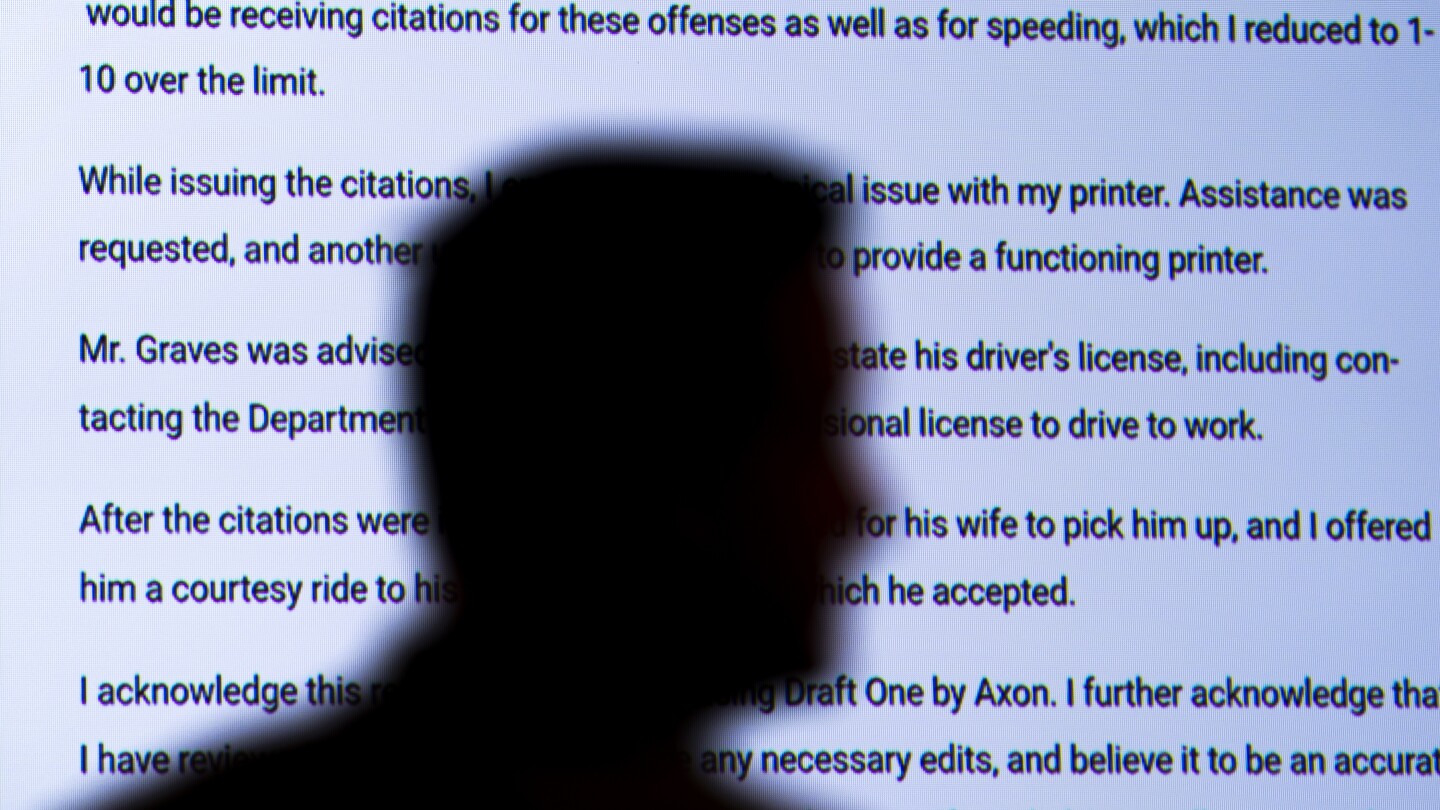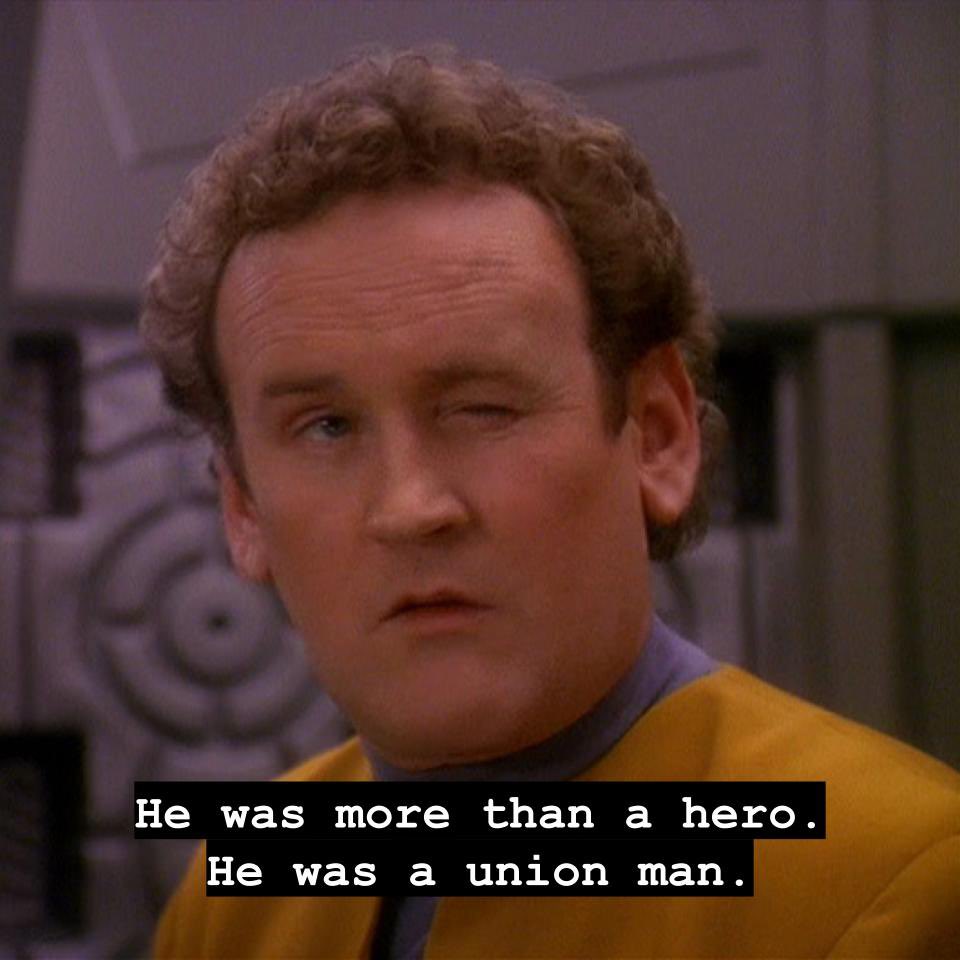A body camera captured every word and bark uttered as police Sgt. Matt Gilmore and his K-9 dog, Gunner, searched for a group of suspects for nearly an hour.
Normally, the Oklahoma City police sergeant would grab his laptop and spend another 30 to 45 minutes writing up a report about the search. But this time he had artificial intelligence write the first draft.
Pulling from all the sounds and radio chatter picked up by the microphone attached to Gilbert’s body camera, the AI tool churned out a report in eight seconds.
“It was a better report than I could have ever written, and it was 100% accurate. It flowed better,” Gilbert said. It even documented a fact he didn’t remember hearing — another officer’s mention of the color of the car the suspects ran from.
When you’re in your lawyer’s office watching the body cam footage from before your arrest for battery, and the police report that results from it only contains the other person’s side of the story, where they lied about your actions, and does not include anything you repeatedly said about how the other person shoved you to the ground – yeah, I can get behind this kind of thing being automated.
Dictated but not read
Yup. How many cops won’t send the AI draft in as a final report?
Without hard rules, it’s just a shortcut waiting to happen.
Lawyer(s) have done it fr
I mean, I assume that a defense attorney is going to go after any potential point of weakness if it’s used as evidence.
But in terms of just providing a summary for internal use, or for public consumption, I imagine that it’s probably fine.
One important point that it can’t capture is an officer documenting beliefs and intentions. A microphone and camera cannot see inside someone’s head. There are points in law where belief is meaningful, and if you don’t write something down at the time, you’re probably not going to remember it months later.
So, for example, let’s take Colorado’s law on when the use of deadly force is permissible:
https://codes.findlaw.com/co/title-18-criminal-code/co-rev-st-sect-18-1-704/
(2) Deadly physical force may be used only if a person reasonably believes a lesser degree of force is inadequate and:
(a) The actor has reasonable ground to believe, and does believe, that he or another person is in imminent danger of being killed or of receiving great bodily injury; or
(b) The other person is using or reasonably appears about to use physical force against an occupant of a dwelling or business establishment while committing or attempting to commit burglary as defined in sections 18-4-202 to 18-4-204; or
(c) The other person is committing or reasonably appears about to commit kidnapping as defined in section 18-3-301 or 18-3-302, robbery as defined in section 18-4-301 or 18-4-302, sexual assault as set forth in section 18-3-402, or in section 18-3-403 as it existed prior to July 1, 2000, or assault as defined in sections 18-3-202 and 18-3-203.
My point is that this is a point where what the law permits rests on what is in someone’s head. There are two requirements: (a) someone has to believe something, and (b) that belief has to be reasonable. So, in Colorado, for example, you cannot make use of deadly force to protect property.
Now, in incidents where deadly force was used, it may be that a higher bar is used – people go out and gather a lot of evidence, everyone is interviewed, whatever. But my point is that a camera and a microphone alone won’t have access to potentially-important information.
Not directly-relevant, but a story that this reminds me of involving state of mind – this one where a camera and video pretty clearly indicated intent – that really stuck with me was a kind of tragic video I saw a while back, involving two police officers and some guy. The police department stuck the videos together and you can watch a unified video and go “oh, no” as it unfolded.
Basically, from memory, what happened was this:
-
Police Officer A – who sounds basically half-asleep, kind of groggy – gets a call about some guy wandering around with a rifle on the street in the early morning, goes to check it out. He pulls up in his car, announces his location on the radio and that he’s found the guy and that he is indeed carrying a rifle. Calls out to the guy. The guy ignores him. Police Officer A asks guy to set his gun down, guy, who sounds pissed-off, tells Police Officer A to go fuck himself or something along those lines.
-
Police Officer A gets on his radio and says that the guy isn’t complying with instructions.
-
Police Officer A goes back to talking to the guy. Guy isn’t happy about that, fires one shot straight up into the air. Now, okay. This is in some residential neighborhood. That’s probably a minor crime, illegal discharge of firearm or something along those lines, can’t be firing without a self-defense justification within a certain distance of residences in most places or something like that. And having someone who is armed with a loaded weapon, is pissed-off, is ignoring a police officer, and is firing random shots into the air isn’t a great situation. But it’s still not that severe. Guy is breaking a couple laws, but he’s also not looking like he’s trying to attack Police Officer A or anyone else, and I don’t think that the initial call to the police reported him threatening anyone. Police Officer A is keeping back, clearly wants some reinforcements present in case this situation goes bad quickly, but also doesn’t feel like the guy is going after him. So, not a great situation, but not that serious.
-
Police Officer A, still sounding kind of groggy but now a little more snapped-into-it, gets on his radio, reports “shots fired”. Now, my guess is that at this point, either policing doctrine is not well-designed or one officer or the other has made a mistake in terminology. Officer B is about two blocks away, in his patrol SUV, rolling up and listening to Officer A’s transmissions as he comes in. Now, okay. What Officer A has said is literally true – the guy has, indeed, fired gunshots. But “shots fired” is also commonly used as something of a quick way of reporting for “I am in a gunfight, and the situation is very serious indeed”. I’ve definitely heard recordings where police officers report “shots fired” with no additional information when they are in a gunfight; they don’t have a lot of time to be dicking around on the radio.
-
Officer B, who cannot yet see the shooter, though I think he could hear the shot from around the block, has formed himself a very different mental picture of the situation than Officer A has. Officer B is thinking “Officer A is being shot at, the shooter has a long gun (more firepower than the police officer), and may already be down.” He goes into “shit is hitting the fan” mode, hits the gas to get there ASAP.
-
Random person trying to be helpful runs out into the street in front of Officer B’s car and points him down the sidestreet, says “the guy’s down there” or something like that. Officer B, who clearly believes that he’s heading into a kill-or-be-killed situation, and wants Random Guy out of potential lines of fire, yells something like “Get out of here, you dumbass! You’ve got no vest, no gun!” He veers around the guy, hits the gas, turns the corner, and tears off down the street with the shooter.
-
Officer A, who if I remember correctly, is crouched behind his patrol car, is still trying to talk to Shooter Guy. He hears Officer B coming up fast. He’s not too worried and doesn’t turn around, figures that Officer B is going to pull up next to him.
-
Officer B sees Shooter Guy on the sidewalk with his rifle near Officer A’s stopped vehicle, has laser-focus on him, and is determined to rescue Officer A. He floors the gas.
-
Officer A hears Officer B not slowing down, can’t figure out what’s going on, starts to turn, and then suddenly it dawns on him. He yells “No, wait! No!” an instant before Officer B rams Shooter Guy with his patrol SUV, launches the guy way into the air and over a wall.
-
Officer A, finally very awake and alert and horrified, yells “Jesus Christ!” He keys his mic, tells dispatch to roll an ambulance and goes running up towards Officer B and Shooter Guy.
Now, in that case, the camera and mics pretty much told the story. I’m not sure who was at error – Officer A using an unqualified “shots fired” report to indicate a situation where he didn’t consider himself at threat from deadly force, Officer B interpreting “shots fired” with no following transmissions as a report indicating that Officer A was taking fire and needed immediate help, or possibly policing doctrine for not making explicit terminology to use in that situation. I think that normally – and I don’t know if this is universal – the initial officer on scene has command of a situation, at least until they hand over control, but I don’t know if Officer B had an obligation to sync up with the commanding officer before using deadly force; he may have also believed that Officer A was down at that point.
But, point is, the beliefs and state of mind can be kind of important.
That was a good read.
-
I’m just as worried about personal information given to the company that owns the AI.
Honestly, dictation is pretty much the only use of LLMs that I’m comfortable with right now. Not “let the police cut corners and rely on it” comfortable, but this is the one thing LLMs are consistently good at.
Of course the police will abuse it, like they abuse everything and everyone, but let’s regulate this shit and make it a useful tool. Then maybe they can have the time to solve some crimes. Oh I always forget, that’s not really their job.
This is actually a pretty good use of AI. I definitely believe the cop saying he couldn’t write anything better. Set up a proper review process, and it could be helpful.
The rules of evidence place a lot (honestly an unreasonable amount) of weight on the value of eyewitness evidence, and contemporaneous reports made from the same. The question for the courts will be, does an AI summary of a video recording have the same value as a human-written report from memory?
I agree that this is good use of AI, but would suggest that th courts should require an AI report to basically have the body cam recording stapled to it, ideally with timestamped references in the report. AI transcriptions are decent, but not perfect, and in cases where there could be confusion the way the courts treat these reports should allow for both parties to review and offer their own interpretations.
This would make sense to include as something that is supplemental to the officers report to help corroborate facts. The question becomes what would happen when the AI summary and officers report conflict
Or when the llm hallucinates shit that didn’t happen?
The biggest problem with this is… who do you blame when it doesn’t work?
Yeah, but we all know that review isn’t going to happen. Reviewing it takes almost as much time, and I’m pretty sure actually more mental effort than just writing it yourself.
Associated Press - News Source Context (Click to view Full Report)
Information for Associated Press:
MBFC: Left-Center - Credibility: High - Factual Reporting: High - United States of America
Wikipedia about this sourceSearch topics on Ground.News








